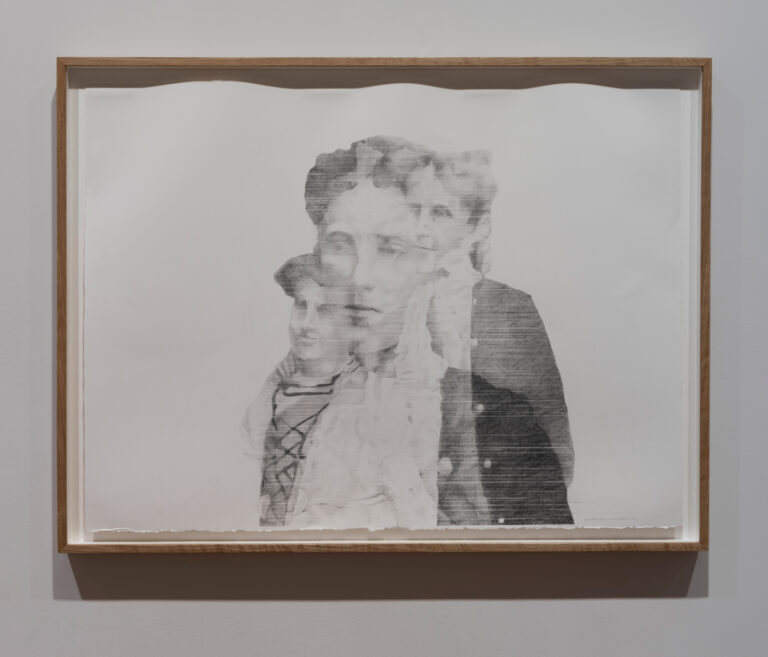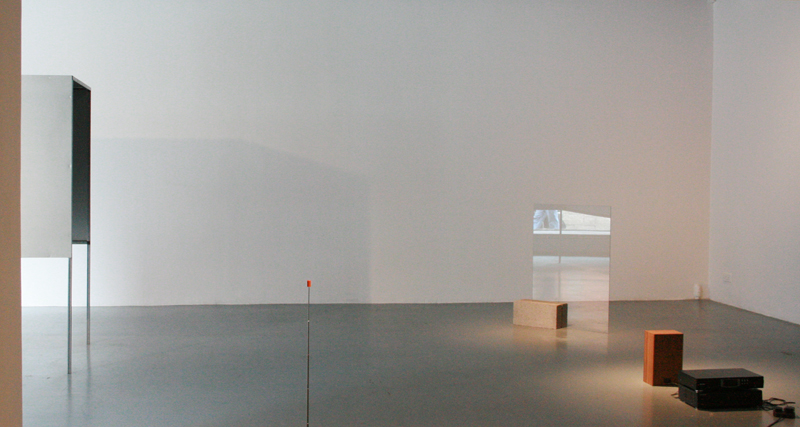Enormous blue barrels brimming with water, stacks of filled jerrycans. The magnitude of liquid featured in Avril Corroon’s recent exhibition at the Project Arts Centre, Dublin, is a literal and confronting manifestation of its title – GOT DAMP. Damp, gathered by dehumidifiers distributed to renters in Dublin and London over a two-year period, forms the primary material for this multimedia installation. This unusual material choice is characteristic of the London-based Irish artist’s work, which often features the unwanted by-products of late capitalist consumer goods and services. GOT DAMP investigates accumulated damp, which is presented as both a purified form – water – and as a dark stain – black mould. This collection of liquid is accompanied by a video work interviewing ten residents who struggle with damp in their homes and contributed the contents of their dehumidifiers to the project.
The exhibition borrows its title from a protest phrase coined by the residents of Thamesmead in south-east London in 1971. Sticking posters reading ‘I’VE GOT DAMP’ in their windows, they garnered attention from politicians, leading to effective redress by the council.1 This incident provides a template for the project’s process of ritualistic collection. Further, by recycling a past slogan of successful protest, the exhibition legitimises damp as a serious issue in contemporary rented accommodation.
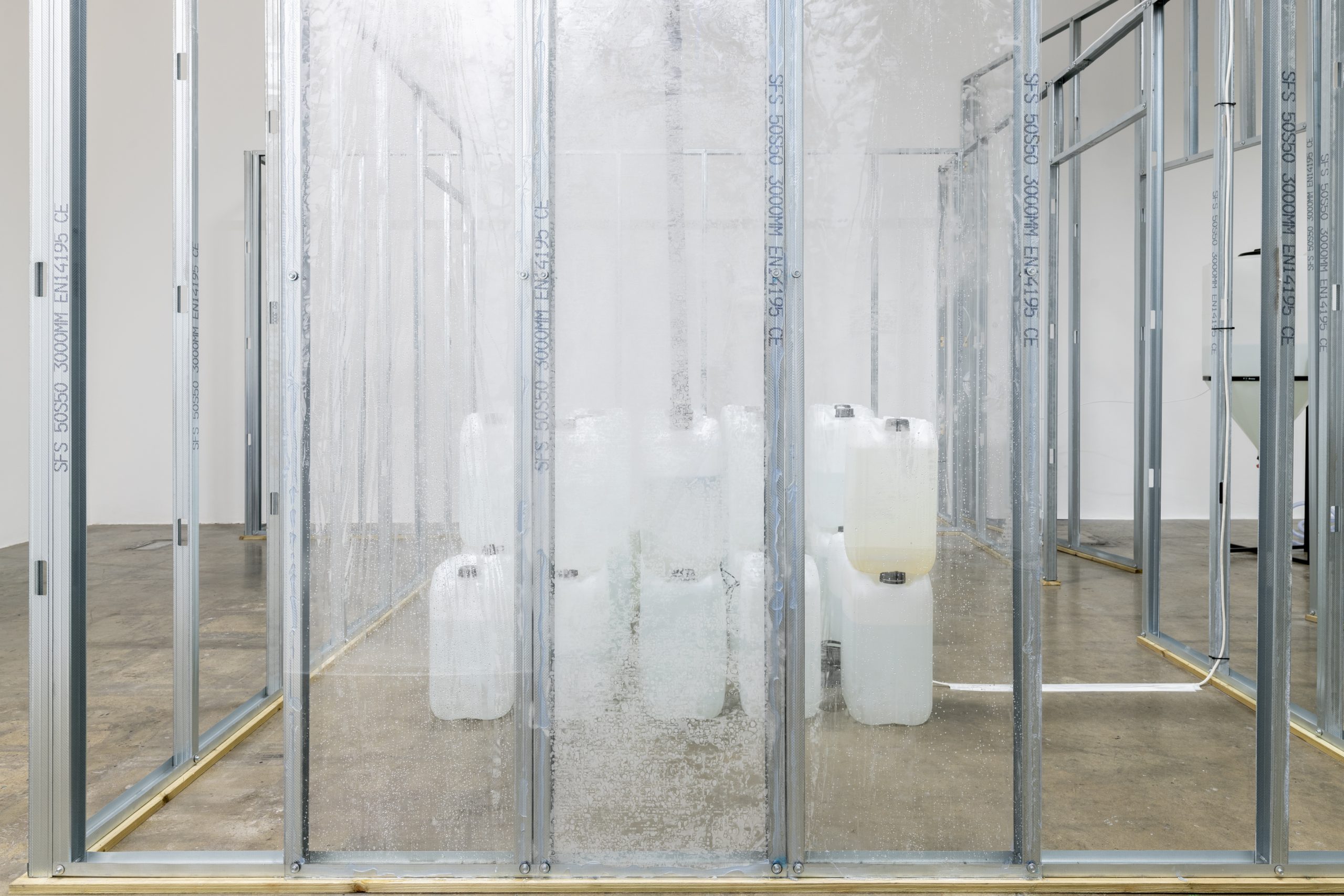
Installation view of Avril Corroon, Got Damp, 2023.
Courtesy of the artist and Project Arts Centre. Photo: Louis Haugh.
On entering the gallery, the visitor is met with an immediate sense of precariousness. The installation pieces together the bare bones of a home: steel studs demarcate rooms and Perspex screens form transparent walls. These insubstantial boundaries replace an atmosphere of security with prison-like confinement. In this house without walls, the only substantial thing is the damp, displayed in overwhelming quantities.
The liquid serves as tangible ‘evidence’ of the elusive condition that stalks the tenants in Corroon’s video.2 Here, damp is not confined to the physical, but forms a permeating soundtrack. A sink gurgles water in tandem with the spinning whine of a washing machine. Dripping, trickling, and gushing, damp makes its presence known. ‘I feel like it’s an actual entity, it’s like me and it,’ one anonymous tenant comments.3 Her efforts to resolve the issue with the agency have proved fruitless: ‘The management company have attended twice regarding it, claiming there is no water or damp, and secondly claiming there is nothing to be done.’4 At once denying and acknowledging damp’s existence, the management’s primary response is to shift culpability onto the tenant. This dismissive approach is an experience shared by many in the film. A particularly striking scene captures a tenant watching television in her sitting room that has a gaping hole in the ceiling overhead, caused by a leak. A stark symbol of decay, the hole has somehow been metabolised by day-to-day living.
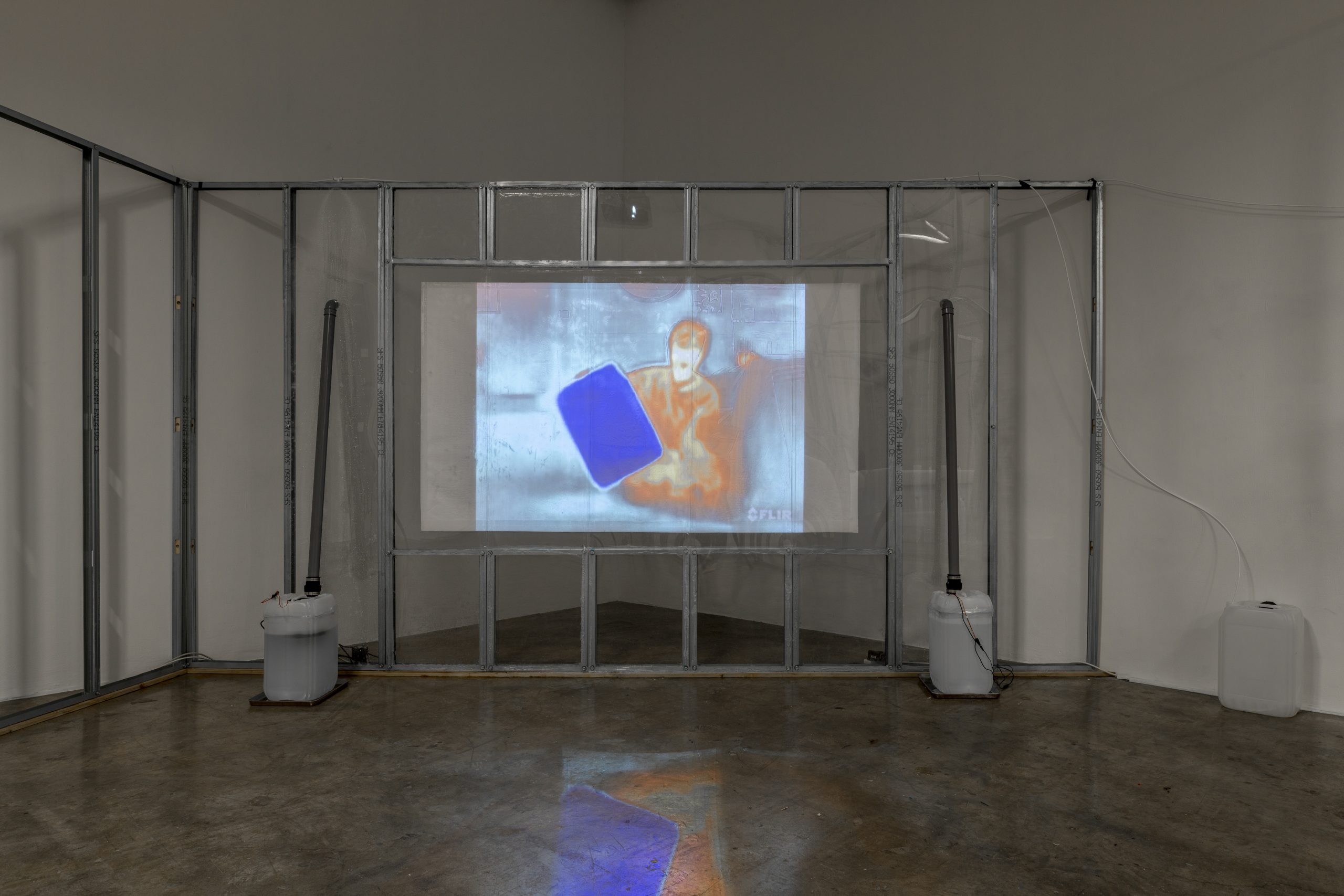
Installation view of Avril Corroon, Got Damp, 2023.
Courtesy of the artist and Project Arts Centre. Photo: Louis Haugh.
Damp’s metamorphic capacity, its ability to be absorbed by daily life, is showcased throughout the exhibition. It pools in large vats, is dispersed via evaporation, condensed in droplets between plastic panes, and, on video, soaks through plaster, sprouting spores. In this way, damp is shown, not simply as a symptom of contemporary precarity, but to embody this state of precarity as a stealthy yet penetrative force, the sheer banality of which renders it generally unremarkable. Corroon adapts a twofold strategy to counter this. First, she captures physical evidence and exhibits it in enormous vessels. Second, she illuminates invisible evidence in thermal camera footage that registers damp in an inky blue, clashing with the pop-colour palette of warm living bodies. In the current climate of crisis-normalisation, gathering substantial proof of this problem becomes a subversive act.
In addition to highlighting the active capacity of mould, the project raises important questions about collective agency. Named after a historic neighbourhood protest, GOT DAMP is also rooted in community practice. Corroon worked with Irish tenants’ union, CATU, to engage in an ongoing exchange with the wider public, trading energy-efficient dehumidifiers for collected damp. In this context, mould gains symbolic weight as both a resistant force and a communicative network. In the video, a scene in which a tenant lays out his mildewed jeans contains a subtle reference to a possible means of change: a well-thumbed copy of Home: Why Public Housing Is the Answer by Irish politician Eoin Ó Broin sits on the desk. The appearance of the book, which traces the systemic roots of Ireland’s housing crisis and proposes the constitutional right to a home, here nudges towards the potential disruption of ingrained attitudes that frame housing as a privatised issue and assert housing conditions as a personal responsibility.
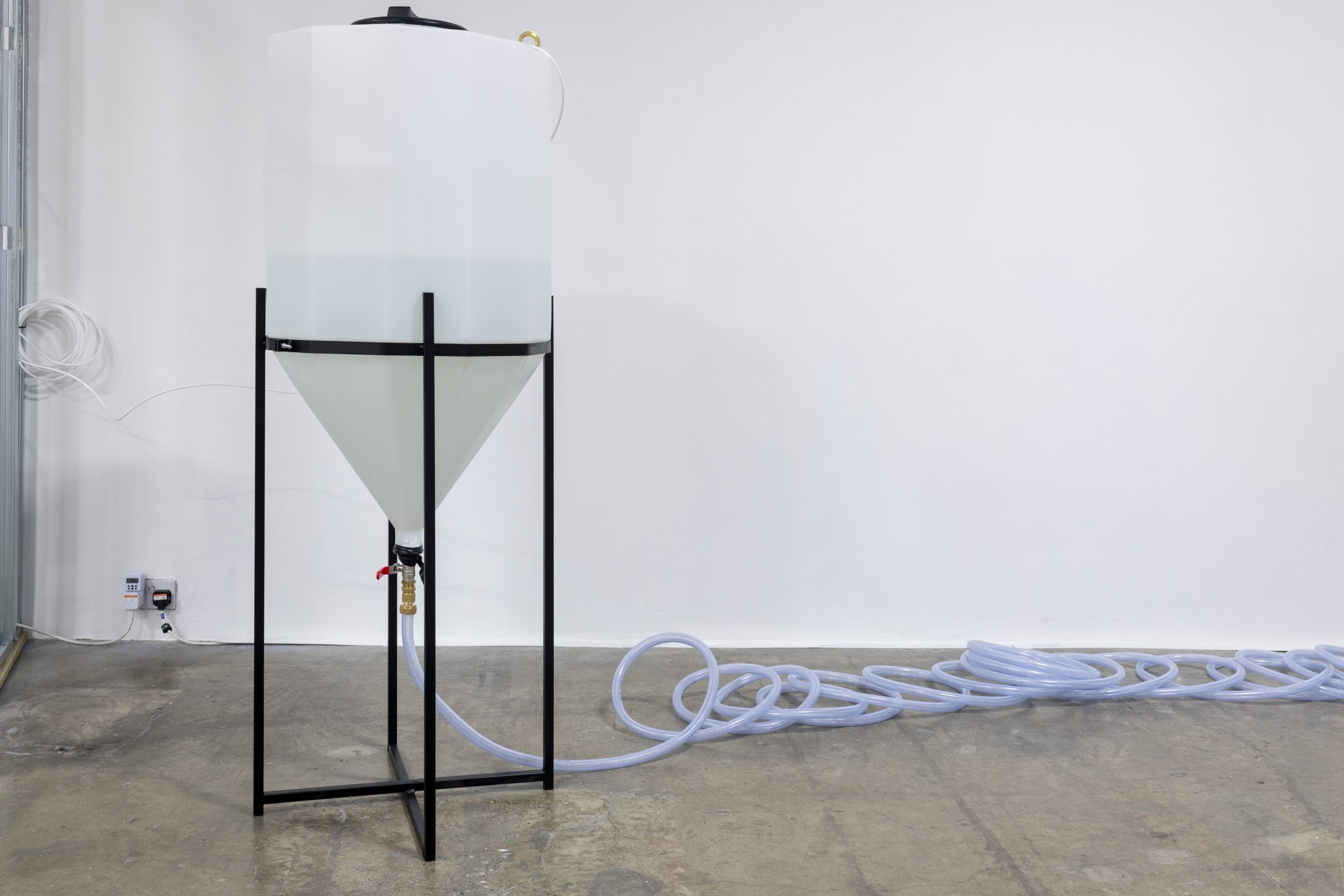
Installation view of Avril Corroon, Got Damp, 2023.
Courtesy of the artist and Project Arts Centre. Photo: Louis Haugh.
The exhibition sets forth a series of marked contrasts: between moisture distillation and evaporation; between damp’s colourless state and its manifestation as dark mould; between the trapped tenant and the absent landlord; and between the confines of a rented room and the evasive structures of housing support. The blood-red silhouettes moving through cold blue thermal footage, and the description of damp as ‘liquid breath’, together allude to the ongoing challenge of simply living in today’s economic climate. Corroon creates a space that explores the inherent contradiction of what Judith Butler refers to as an ‘unliveable’ life.5 By interrogating the given conditions of our day-to-day lives and building evidence of the ways in which these conditions render life precarious, Corroon declares a state of crisis that gives importance and urgency to the mundane.
GOT DAMP avoids simply portraying a grim reality and instead unpacks the contained, privatised issue of damp as an endemic symptom of cold, careless policies. In doing so, the project crosses the gallery threshold into the public sphere, actively engaging with communities and highlighting mould’s potential as a symbol of resistance.
Niamh Darling is currently completing her MA in Arts and Culture: Art History at Leiden University.
Notes
1 ‘GOT DAMP / PÚSCADH ANUAS’, Project Arts Centre, press release, https://projectartscentre.ie/event/got-damp-avril-corroon/.
2 Avril Corroon, ‘Got damp? Artist Avril Corroon on “a crisis of nature in the home”’, RTÉ, 15 April 15, 2023. https://www.rte.ie/culture/2023/0415/1376242-avril-corroon-on-making-art-from-700-litres-of-dublin-damp/.
3 Quote from project participant, Avril Corroon, GOT DAMP (2023), video, 29:59, 2023.
4 Ibid.
5 Judith Butler in Butler and Frédéric Worms, The Livable and the Unlivable (New York: Fordham University Press, 2023), 13-14.


